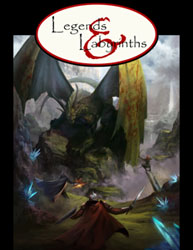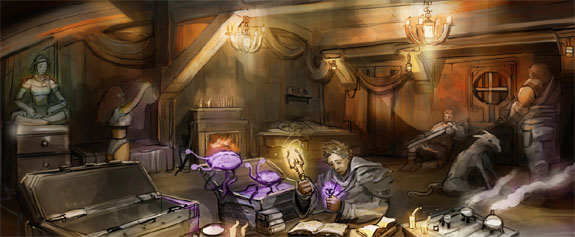 I remember a time when dice were far more important than they are today. It used to be that a “true gamer” attempted to find as many different types of dice as he possibly could. You started your collection by getting the essentials – the d4, the d6, the d8, the d10, the d12, and the d20. You usually got these in the boxed set along with your rulebook. These were generally cheap. You’d later upgrade these cheapies so that you had marbled or gem dice. Then you’d begin to add on the more exotic types. My first exotic die was the fabled d100… which, if you rolled it in 1988, would probably still be going if it hadn’t gone off the end of the table and hit the wall. My second was a purple d30. I once knew a guy who had a d12 printed with the digits 1-6 and 95-00. I never did figure out what the hell that thing was for. But it was cool.
I remember a time when dice were far more important than they are today. It used to be that a “true gamer” attempted to find as many different types of dice as he possibly could. You started your collection by getting the essentials – the d4, the d6, the d8, the d10, the d12, and the d20. You usually got these in the boxed set along with your rulebook. These were generally cheap. You’d later upgrade these cheapies so that you had marbled or gem dice. Then you’d begin to add on the more exotic types. My first exotic die was the fabled d100… which, if you rolled it in 1988, would probably still be going if it hadn’t gone off the end of the table and hit the wall. My second was a purple d30. I once knew a guy who had a d12 printed with the digits 1-6 and 95-00. I never did figure out what the hell that thing was for. But it was cool.
Of course, then again, perhaps it’s only in my circle of gaming friends that this slow deemphasization has taken place. Perhaps other groups are still possessed of massive dice infatuations. Perhaps. I think it far more likely that the maddened collectors in this industry have all turned to CCGs for their fix. Certainly roleplaying games themselves seem to have retreated to a “single type of die” philosophy over the past decade. It’s no longer common to see a discussion of the differences between d6s, d4s, d8s, d10s, d12s, and d20s comfortably squeezed in between “An Example of Play” and “What is a Roleplaying Game?” in the first section of your rulebook.
All of this palpable nostalgia I have summoned up is only for the purpose of explaining where this “product of time” came from. DeathDice from Flying Buffalo, Inc. is a plastic tube of five six-sided dice – three of which have one side printed with a skull, two of which have one side printed with Grimtooth’s head (Grimtooth, of course, being their semi-cute trollish creature made famous by the Grimtooth Traps volumes… which, of course, you youngsters probably don’t know either… sigh…). The small sheet which comes with the dice is printed with advertisements for other Flying Buffalo products on one side and the rules for a simple dice game called Skulls on the other (which only requires two skull dice – no rules are given which explain why you’d need three… let alone two Grimtooth dice). The rules for Skulls basically consist of rolling the dice over and over again until you either decide to stop or roll a Skull on one of the dice (which causes you to lose all your points for that round).
The skull prints on the dice are blurry and don’t seem to be based on particularly good drawings to begin with. On the other hand, Grimtooth looks as handsome as ever.
I can’t recommend this product to you… unless of course you’re looking for some truly unique dice to add to your collection. (And don’t deny it: You’ve still got it, even if you don’t use it all that much any more.)
Style: 3
Substance: 2
Company/Publisher: Flying Buffalo, Inc.
Cost: $4.50
Page count: n/a
ISBN: n/a
Originally Posted: 1999/05/28
About a year after I wrote this review, I had a backpack stolen which contained my entire collection of WEG Star Wars sourcebooks and my dice bag. I had built the collection of Star Wars supplements up because I was playing in a really great Star Wars campaign run by my friend Dave Blackmer. In the years since then, I’ve only replaced the core rulebooks.
My collection of dice, on the other hand, had been built up from the very first day I bought the BECMI Basic Set. It included the dice that came with the Basic Set (including a truly ugly pink-and-black d12), but it also included a complete set of waxed dice from the original Basic Set, the d100 and d30 talked about in this review, and countless others that represented an eclectic adolescence of gaming. And the dice bag was actually one that I had inherited from father. It was literally irreplaceable.
These days I own a lot of dice, but I don’t collect them: I own several varied sets, but they’ve all been purchased for explicitly utilitarian purposes. The exceptions are a hodge-podge of d10s which I received as a donation from my brother-in-law and a set of three d6’s which were wedding favors at my brother’s wedding. (I keep those in my bag to breed good luck… which is ironic, because my dice are frequently being used to kill the characters of my brother and sister-in-law.)
On a similar note, one last dice-related anecdote: The first dice I bought to replace my stolen dice bag was a set of black dice with red numbers. To supplement this set, I purchased additional, matching d6’s (’cause D6 Star Wars). Within only a few weeks of purchase, one of these d6’s shattered in my dice bag — leaving one big chunk and a number of shards. I still keep this entire d6 (in pieces) in my dice bag to soak up all the bad luck.
I may not be a collector, but I wouldn’t be a gamer if I didn’t have dice superstitions, right?
For an explanation of where these reviews came from and why you can no longer find them at RPGNet, click here.





 Two weeks ago
Two weeks ago










